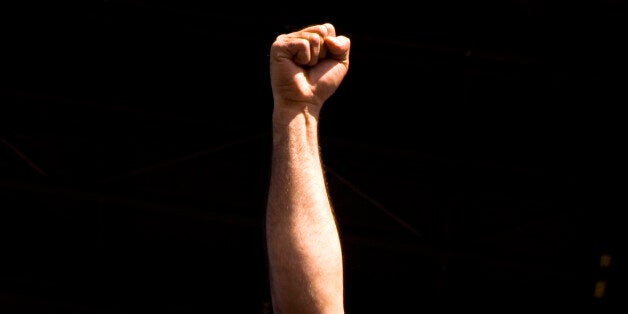
Hashtags began as a way to search for tweets about specific topics (#socialmedia), evolved into a tool for adding nuance (#ohyeah) and are now showing up in places where they appear to serve no practical function whatsoever: on T-shirts, book covers, purses and signs. We can’t click on physical objects. But we throw hashtags on there anyway.
Michelle Obama did as much this week when she tweeted a photograph of herself holding a piece of paper with the handwritten words "#Bring Back Our Girls.” The phrase, a reference to the over 200 young women kidnapped by an extremist group in Nigeria, could have said “Bring Back Our Girls,” plain and simple. Instead, it led with the hash symbol.
Obama’s choice of prefix demonstrates how the hashtag has taken on yet another function since its debut seven years ago: It is a command. The four perpendicular lines have become shorthand for "share this and share this now."
Hashtags turn a phrase into a slogan. Think of them as the raised fist of punctuation.
"The hashtag says, ‘This is something you need to have your attention drawn to right at this moment,’ and ‘This is something you can get involved with and be associated with and show your support for,’" said Ruth Page, a professor at the University of Leicester whose research focuses on social media and language. "It's like a call for action."
The rise of the hashtag-as-command coincides with the hash’s creep beyond typed text and into images and videos, or even onto objects, where they fulfill no technical purpose whatsoever (Click the typed word “#cappuccino” on almost any social media site, and you’ll be shown all other posts that include the term. Click an image containing “#cappuccino” and, well, nothing happens). Consider that “#BringBackOurGirls” has not only been typed in over 2 million tweets, but it’s also been stamped on thousands of photos shared to Instagram. Sophia Amoruso, the founder of NastyGal, featured a hashtag as the title to her (paper) book, “#GIRLBOSS.” And more than half of advertisers in this year’s Super Bowl included hashtags in their commercials -- a not-so-subtle hint we should repeat their slogans, not just see them.
These photographed and filmed hashtags show that people now embrace the hash as much more than a way to organize information and, rather, as an instruction to spread it.
The hashtag has evolved into a subconscious cue for “repeat,” thanks in part to its early associations with politics and trending topics.
“There may be two historical antecedents that converge in the sloganizing of hashtags: on the one hand, you have the use of hashtags to talk about political causes on Twitter and on the other, there’s the use of hashtags to cause topics to trend,” said Susan Herring, a professor of information science and linguistics at Indiana University, referencing Twitter’s list of “trending topics," which early on pulled extensively from hashtagged terms.
Though the earliest Twitter hashtag was used in connection with a tech meetup (#barcamp), Herring noted that hashtags gained mainstream recognition during the 2009 Iranian revolution, when terms like “#IranElection” and “#Neda” coursed through the service. And early on, the "hash" was associated with an effort to get the word out: "Hashtags are originally assumed to be clickable and spreadable, and the reason that you use them, at least some of the time, is because you want to create a trending topic,” Herring said.
The flattening of text that occurs online has also helped give rise to the “sloganizing” function of hashtags. In an earlier age, we’d have recognized a slogan from the way it was lettered on placards, pins or billboards. We had exclamation marks. Big, colorful block letters. Uncle Sam pointing. Now, we’ve got 140 characters that look the same no matter what we write. “We don’t have as much typographic variation available if we’re just typing on Twitter or Instagram,” Herring said.
Tweeting “We can do it” carries none of the oomph of the original World War II Rosie the Riveter poster. It could be a reference to getting more followers, a cheer for a football team or part of a fundraising push -- or all of the above, according to some recent tweets. But “#WeCanDoIt”? Now you’ve got the seeds of a movement.
Or perhaps you have only a catchy slogan. While it's possible hashtags like "#BringBackOurGirls" or "#IAmBradleyManning" yield policy change, it seems more often than not, hashtags are most effective at spreading hashtags -- and less able to spark offline action. See if you can start a hashtag that fixes that.
